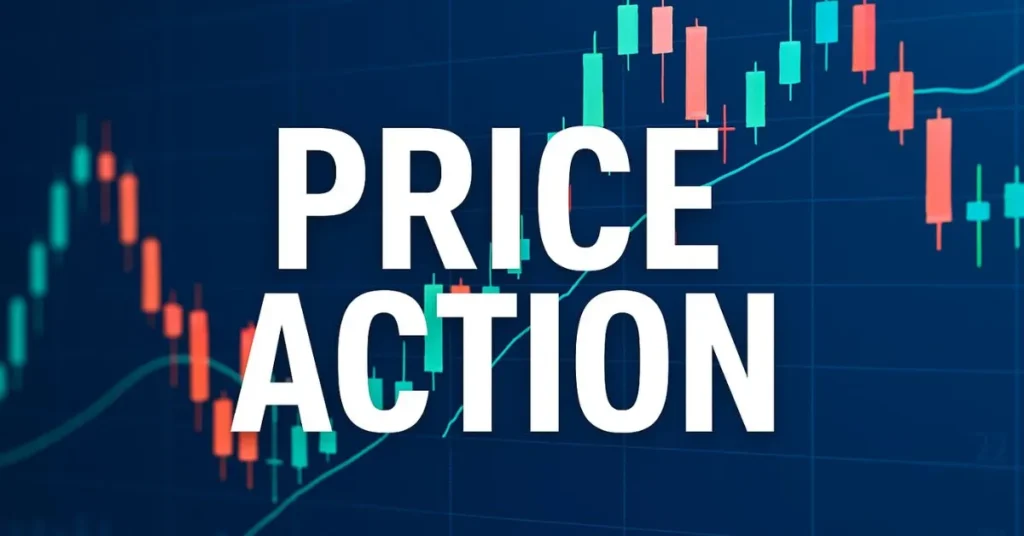Understanding how markets move can feel like deciphering an ancient code. Yet Price action brings clarity: it’s the pure study of how prices move on a chart, free from laggy indicators or complex overlays. Traders who base decisions on price action read raw market data—the open, high, low, and close of each candle—to gauge sentiment and anticipate the next move. By focusing on patterns created by buyers and sellers, you tap directly into the tug-of-war that drives every bullish rally or bearish slide. Embedding the term Price action into your vocabulary early helps ensure that every chart you analyze tells a story you can trust and act upon.
Price action isn’t just another buzzword. It’s a toolkit built on observation, discipline, and adaptability. Rather than chasing the latest algorithm or hoping a moving average magically signals a turning point, you learn to read the market’s heartbeat. Every swing high or low, every engulfing candle or breakout bar, becomes a piece of evidence. The more you practice, the more you recognize the language spoken by price. And once you’re fluent, you can make trading decisions with confidence and precision.
Understanding Price action Basics
At its simplest, Price action involves reading price bars and candlesticks to identify market direction and potential reversal points. You strip away the noise of oscillators and moving averages, choosing instead to watch how price interacts with key levels. These levels might be obvious trendlines, previous swing lows and highs, or psychologically significant round numbers like 1.3000 in forex. When price tests these levels, the reaction—whether a swift rejection or a breakout—becomes a signal. Traders skilled in price action learn to differentiate a false break from a genuine shift in market sentiment.
To build a solid foundation, focus on these elements:
- Price bars and candlestick shapes
- Horizontal support and resistance
- Trendlines and channels
- Swing highs and lows
- Volume or time-of-day considerations
Mastering these basics lets you move beyond textbook definitions into real-world application. As you catalog examples in your trading journal, patterns begin to emerge—patterns that indicate whether bulls or bears hold the edge. Soon, reading a naked chart feels as intuitive as reading your favorite novel.
Recognizing Market Structure through Price action
Market structure is the skeleton of every chart. It’s the arrangement of swing highs, swing lows, and the directional bias that connects them. Trend analysis hinges on identifying higher highs and higher lows in an uptrend, or lower highs and lower lows in a downtrend. Price action helps you see these patterns immediately, without waiting for confirmation from lagging tools. By zooming out on multiple timeframes, you gain perspective on whether a move is a small retracement or a major reversal.
When you identify a valid swing point, you anchor trendlines or channels, which serve as guides for future entries and exits. For example, a four-hour chart might show a well-defined up channel that has held support three times. Each test of the lower trendline presents an opportunity to buy near support, with stops placed just below the channel. Recognizing market structure through clean price action charts sharpens entries and minimizes guesswork.

Identifying Support and Resistance Zones
Support and resistance define the battlefield where buyers and sellers clash. Price action teaches you to spot these zones without relying on dense indicator clusters. Look for areas where candles have repeatedly stalled or reversed. A series of pin bars at the same price level signals strong rejection, marking a support or resistance zone in your charting software.
Building reliable zones involves:
- Drawing horizontal lines at areas with multiple touches
- Using past congestion areas where price traded sideways
- Considering round numbers and psychological levels
- Expanding lines into zones to account for minor breaches
By visualizing these zones, you know where to anticipate battle and adjust your risk. When price revisits a major resistance zone, you wait for rejection signals like bearish engulfing patterns or wick extensions before selling. Properly drawn support and resistance acts as the scaffolding for all your price action strategies.

Leveraging Candlestick Patterns within Price action
Candlestick charts give you a rich vocabulary of patterns to interpret. Each pattern—whether a single-bar signal like a pin bar or a multi-bar formation like an inside bar—tells a unique story about battle intensity between bulls and bears. In price action trading, these patterns become the punctuation marks in your market narrative.
Below is a comparison of common price action candlestick patterns:
| Pattern | Type | Description |
|---|---|---|
| Pin Bar | Reversal | Long wick signals rejection of higher or lower price |
| Inside Bar | Continuation | Smaller bar within previous bar, indicates pause |
| Engulfing Candle | Reversal | Body fully engulfs previous, signals strong rejection |
| Tweezer Top/Bottom | Reversal | Matching highs or lows showing potential rejection |
| Fakey | False Break | Inside bar followed by false breakout |
Understanding these patterns helps you respond to price action in context. For instance, coupling an inside bar with a major support zone and a bullish trendline break creates a high-probability setup.
Entry and Exit Strategies Using Price action
Identifying a pattern is only half the battle. You need clear entry and exit rules to translate insights into profits. A consistent price action strategy combines valuable signals with sensible risk management.
Effective price action entries often rely on confluence—when multiple factors align:
- A pin bar at a key support area in an uptrend
- An inside bar break in the direction of the prevailing trend
- A wick rejection coinciding with a trendline test
These confluences increase the odds that price respects the level and continues in the anticipated direction. For exits, consider:
- Setting profit targets at the next major zone
- Trailing stops behind new swing lows or trendlines
- Exiting part of your position when price action weakens
Link your entry and exit to price action signals instead of fixed pip targets. This flexibility adapts to market volatility, allowing you to ride strong trends and exit when momentum fades.
Crafting a Price action Trading Plan
A robust trading plan is your blueprint for consistent execution. It transforms price action observations into actionable steps. Start by defining:
- Markets and timeframes you’ll focus on
- Types of price action setups you trade
- Risk per trade and maximum daily losses
- Journaling routine to review each setup
Document your entry rules, stop placement, and profit management under the “price action strategy” section of your plan. When markets shift, revise your plan rather than improvising. Discipline comes from following a written process, not from memorizing every pattern or indicator.
Regularly backtest your documented setups on historical charts, noting win rates and average return per trade. If a pattern underperforms, tweak your criteria or drop it. A tailored price action plan becomes your compass through calm ranges and volatile trends alike.
Risk Management Essentials for Price action Traders
Even the best price action strategy fails without proper risk control. Your trading capital depends on strict rules for position sizing and stop placement. In price action, stops go beyond fixed percentage losses; they tie directly to chart structure.
Key risk management guidelines:
- Risk no more than 1–2% of capital on any trade
- Place stops just beyond the invalidation point of your setup
- Use volatility measures, like Average True Range (ATR), to adjust stop distance
- Diversify across different instruments or timeframes
For example, if a bearish engulfing candle breaks support, place a stop above the candle’s high. This structure-based stop respects market volatility and avoids getting whisked out by random spikes. Solid risk management turns price action setups into repeatable, profitable trades over time.
Cultivating the Right Mindset for Price action Success
Trading price action demands patience and psychological resilience. You’ll experience periods of consolidation where setups are scarce—and moments where multiple high-probability signals appear. The key is to stay disciplined and avoid forcing trades.
Adopt these mental habits:
- Embrace quality over quantity: wait for your best setups
- Keep ego in check: accept small losses without hesitation
- Focus on the process: track adherence to your trading plan
- Review every trade objectively, regardless of outcome
Over time, you’ll notice patterns in your own behavior—impulsive entries, holding losers too long, or abandoning setups prematurely. Journaling these tendencies alongside price action notes helps you identify and correct counterproductive habits.

Advanced Price action Techniques
Once you’ve mastered basics, explore advanced techniques that deepen your edge. Layer multiple timeframes to isolate points where higher- and lower-timeframe signals align. For instance, a four-hour downtrend showing a bearish flag, paired with a 15-minute pin bar at a minor resistance, can produce precise entries with tight risk.
Another tactic is order flow divergence: observing small-timeframe momentum slowing beneath a key zone even as price makes fresh highs. This micro-level weakness often precedes a rejection candle, signaling an optimal short entry.
Linking these methods with volume analysis or proprietary liquidity maps can further refine your entries. Yet beware of overcomplicating your charts—true price action purists maintain simplicity while harnessing advanced context.
Real-world Examples and Case Studies
Theory comes alive when you dissect actual trades. Let’s examine a forex example on EUR/USD:
On July 15, the pair traced a rising channel, repeatedly bouncing off the lower trendline. After three clean tests, a four-hour pin bar formed at channel support. You entered long with a stop below the pin bar’s low, risking 1% of capital. Price surged, hitting the channel’s upper boundary, where you took profit—netting a 1.8% return.
In equities, consider Apple Inc. (AAPL) during its March pullback. A daily inside bar formed at a key previous support zone. Waiting for a break above the bar’s high, you entered with a stop beneath its low. Over the next ten days, the stock climbed 12%, demonstrating price action’s adaptability across asset classes.
Next Steps on Your Price action Journey
Now that you understand what Price action entails, commit to a structured practice routine. Dedicate daily time to chart analysis, focusing on one market and timeframe until you can recognize high-probability patterns without hesitation. Automate your journaling process to record entries, exits, and emotional notes.
Balance your chart time with theory—read case studies of master traders like Nial Fuller and Al Brooks, who distilled decades of experience into accessible lessons. Finally, simulate your price action strategies in a demo account before risking capital. This methodical approach transforms raw market data into repeatable profits and lifelong trading skills.



